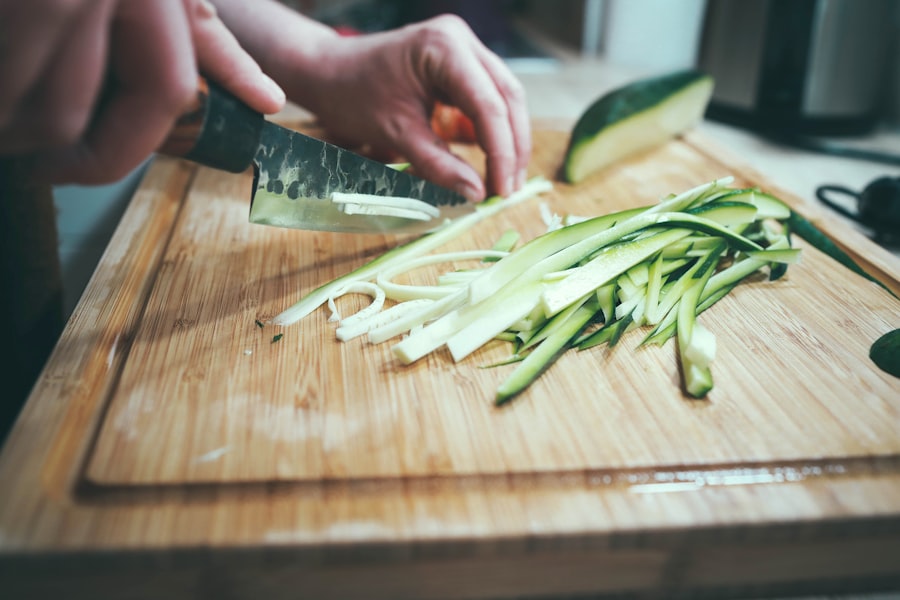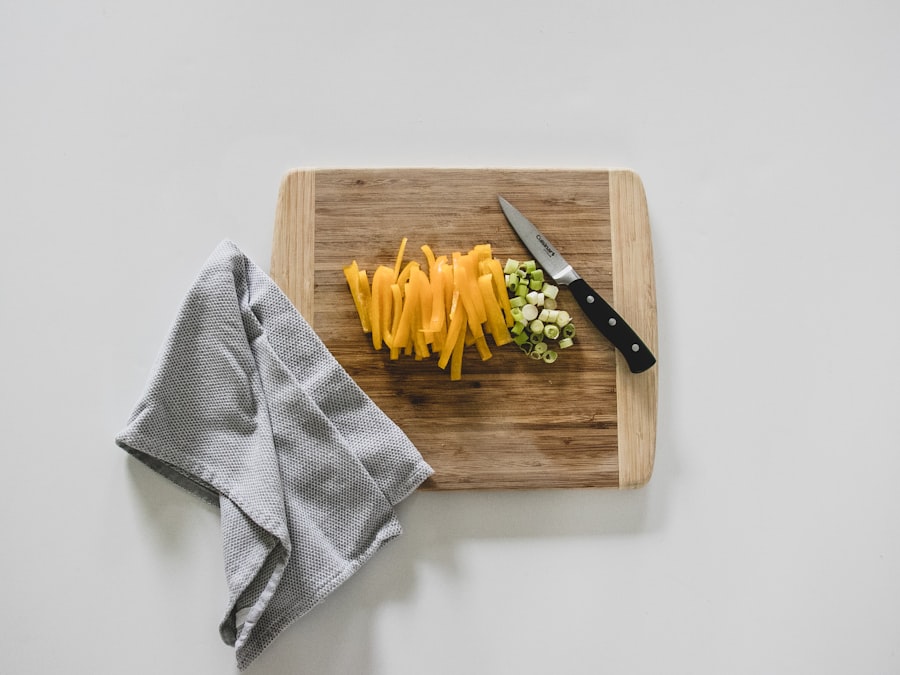Knife skills are foundational to culinary arts, serving as the bedrock upon which a cook’s efficiency and creativity are built. Mastering the art of handling a knife not only enhances the speed and precision of food preparation but also elevates the overall quality of the dishes being created. A chef with proficient knife skills can transform a simple ingredient into a beautifully presented dish, showcasing the importance of technique in the kitchen.
The ability to chop, dice, julienne, and chiffonade with confidence allows for a more fluid cooking process, enabling cooks to focus on flavor development and presentation rather than struggling with basic tasks. Moreover, knife skills contribute significantly to food safety. Proper cutting techniques minimize the risk of accidents and injuries, which are all too common in kitchens where individuals lack training.
For instance, understanding how to hold a knife correctly and how to position food while cutting can prevent slips and cuts. Additionally, uniform cuts ensure even cooking, which is crucial for achieving the desired texture and flavor in dishes. Thus, honing knife skills is not merely about aesthetics; it is an essential aspect of culinary competence that impacts both safety and quality.
Key Takeaways
- Knife skills are essential for efficient and safe cooking
- Choosing the right knife for the task is crucial for achieving the best results
- Basic knife techniques include chopping, slicing, and dicing
- Advanced knife techniques involve precision cuts and decorative garnishes
- Knife safety is paramount to prevent accidents in the kitchen
Choosing the Right Knife
Selecting the appropriate knife is a critical step in developing effective knife skills. The market offers a plethora of options, each designed for specific tasks, making it essential for cooks to understand their needs before making a purchase. A chef’s knife, typically ranging from 8 to 10 inches in length, is often considered the workhorse of the kitchen.
Its versatility allows it to handle a variety of tasks, from chopping vegetables to slicing meat. For those who frequently work with herbs or delicate ingredients, a paring knife is indispensable for intricate tasks such as peeling or deveining. In addition to the type of knife, factors such as weight, balance, and handle design should also be considered.
A well-balanced knife feels comfortable in hand and allows for greater control during use. For instance, a heavier knife may be beneficial for chopping through dense vegetables, while a lighter knife may be preferable for precision tasks. Furthermore, the material of the blade—whether stainless steel, carbon steel, or ceramic—can influence performance and maintenance requirements.
Understanding these nuances can help cooks select knives that not only suit their cooking style but also enhance their overall experience in the kitchen.
Basic Knife Techniques

Basic knife techniques form the cornerstone of culinary proficiency and are essential for anyone looking to improve their cooking skills. One of the most fundamental techniques is the proper grip on the knife. The pinch grip involves pinching the blade between the thumb and index finger while wrapping the remaining fingers around the handle.
This grip provides better control and stability compared to holding the handle alone. Coupled with a stable cutting board and proper body positioning, this grip allows for more precise cuts. Chopping is another essential technique that every cook should master.
The rocking motion of a chef’s knife allows for efficient chopping of herbs, vegetables, and other ingredients. To chop effectively, one should keep the tip of the knife on the cutting board while using a gentle rocking motion to bring the blade down onto the food. This technique not only increases speed but also ensures uniformity in size, which is crucial for even cooking.
Other basic techniques include dicing, which involves cutting food into small cubes, and slicing, which requires smooth, even strokes to create thin pieces. Mastery of these techniques lays the groundwork for more advanced skills.
Advanced Knife Techniques
| Technique | Description |
|---|---|
| Julienne | Cutting vegetables or fruits into thin matchstick-shaped pieces. |
| Chiffonade | Stacking and rolling leafy greens or herbs, then slicing into thin strips. |
| Batonnet | Cutting vegetables into long, thin sticks, similar to French fries. |
| Chopping | Cutting food into small, irregular pieces. |
| Mincing | Cutting food into very small pieces, smaller than chopping. |
Once basic knife skills are established, cooks can explore advanced techniques that further enhance their culinary repertoire. One such technique is the chiffonade, which involves stacking leafy greens or herbs, rolling them tightly, and slicing them into thin ribbons. This method not only adds visual appeal to dishes but also maximizes flavor release from herbs when used as a garnish or ingredient in salads and sauces.
Another advanced technique is filleting fish or meat. This requires precision and an understanding of anatomy to separate flesh from bone without wasting any product. A flexible filleting knife is often used for this purpose, allowing for smooth cuts along the contours of the fish or meat.
Mastering this technique not only improves presentation but also allows cooks to utilize whole animals or fish more efficiently, reducing waste and promoting sustainability in cooking practices.
Knife Safety
Knife safety is paramount in any kitchen environment, as improper handling can lead to serious injuries. One of the most critical aspects of knife safety is maintaining awareness of one’s surroundings while using a knife. Cooks should always be mindful of where their hands are in relation to the blade and ensure that others are at a safe distance when cutting.
Additionally, using a stable cutting board prevents slips that could result in accidents. Proper storage and handling of knives also play a significant role in safety. Knives should never be left loose in drawers where they can cause injury when reaching for other utensils.
Instead, using magnetic strips or knife blocks can keep blades secure and easily accessible. Furthermore, it is essential to keep knives sharp; dull blades require more force to cut through food, increasing the likelihood of slips and accidents. By adhering to these safety principles, cooks can create a safer kitchen environment while honing their skills.
Knife Maintenance

Cleaning Knives
It is advisable to wash knives by hand with mild soap and warm water rather than placing them in a dishwasher, as high temperatures and harsh detergents can damage both the blade and handle materials.
Inspecting Knives
In addition to cleaning, routine inspections for signs of wear or damage are essential for maintaining knife integrity. A well-maintained knife should have no chips or nicks on its edge; if such imperfections are found, they should be addressed promptly through sharpening or professional repair.
The Benefits of Maintenance
Proper maintenance not only extends the life of knives but also ensures that they perform optimally during food preparation.
Knife Sharpening
Sharpening knives is an art form that requires practice and understanding of various sharpening methods. A sharp knife is safer than a dull one because it requires less force to cut through food, reducing the risk of slips and accidents. There are several methods for sharpening knives, including whetstones, honing rods, and electric sharpeners.
Each method has its advantages; whetstones allow for precise control over sharpening angles but require more skill and time, while electric sharpeners offer convenience but may not provide as fine an edge. The process of sharpening involves removing material from the blade to create a new edge. For those using whetstones, it’s important to maintain a consistent angle—typically around 20 degrees—for optimal results.
Regular honing with a honing rod can help maintain an edge between sharpenings by realigning any misaligned particles on the blade’s edge. Understanding when and how often to sharpen knives depends on usage frequency; professional chefs may need to sharpen their knives weekly, while home cooks might find monthly maintenance sufficient.
Knife Storage
Proper storage of knives is essential not only for safety but also for preserving their sharpness and integrity over time. Storing knives incorrectly can lead to dull blades or accidental cuts when reaching into drawers or cabinets. One popular method for storing knives is using magnetic strips mounted on walls; this keeps blades visible and easily accessible while protecting them from damage.
Another effective storage solution is a wooden knife block that holds knives securely in place while preventing them from clashing against one another. For those with limited counter space, drawer inserts designed specifically for knives can keep them organized and protected from nicks or scratches. Regardless of the storage method chosen, ensuring that knives are stored safely will prolong their lifespan and maintain their performance in food preparation.
The Role of Knife Skills in Cooking
Knife skills play an integral role in cooking that extends beyond mere preparation; they influence every aspect of culinary creation from flavor development to presentation. The way ingredients are cut affects their cooking times and textures; for example, finely diced onions will caramelize faster than larger chunks due to increased surface area exposure to heat. This understanding allows cooks to manipulate ingredients effectively to achieve desired outcomes in their dishes.
Furthermore, presentation is significantly enhanced by skilled knife work. A dish garnished with perfectly sliced vegetables or herbs not only looks appealing but also indicates attention to detail and professionalism in cooking. In fine dining establishments, where visual aesthetics are paramount, exceptional knife skills can elevate a dish from ordinary to extraordinary by showcasing ingredients in their best light.
Benefits of Taking a Knife Skills Class
Enrolling in a knife skills class offers numerous benefits that extend beyond simply learning how to cut vegetables more efficiently. Such classes provide structured learning environments where participants can receive hands-on instruction from experienced chefs who can offer personalized feedback on technique and form. This immediate guidance helps students correct mistakes early on, fostering better habits that will serve them throughout their culinary journeys.
Additionally, knife skills classes often cover various topics such as knife selection, maintenance techniques, and safety protocols that may not be readily available through self-study or online tutorials. Participants gain confidence as they practice under supervision, allowing them to experiment with different techniques without fear of injury or failure. Ultimately, these classes empower individuals with knowledge that enhances their overall cooking experience.
Finding the Right Knife Skills Class
When searching for a suitable knife skills class, several factors should be considered to ensure an enriching experience tailored to individual needs. First and foremost is identifying whether one prefers an online course or an in-person workshop; both formats have unique advantages depending on personal learning styles and schedules. In-person classes often provide immediate feedback and hands-on practice with instructors present, while online courses offer flexibility in timing and location.
Additionally, researching instructors’ backgrounds can provide insight into their teaching styles and expertise levels; experienced chefs with professional backgrounds may offer valuable industry insights alongside practical skills training. Reading reviews from past participants can also help gauge whether a class meets expectations regarding content quality and instructor engagement. Ultimately, finding the right class involves aligning personal goals with available options to ensure a fulfilling learning experience that enhances culinary skills through effective knife handling techniques.



